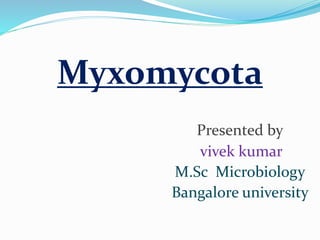
Myxomycota
- 1. Myxomycota Presented by vivek kumar M.Sc Microbiology Bangalore university
- 2. Introduction The myxomycota differs from true fungi because their vegetative body consists of only protoplast bounded by membrane and devoid of cell wall and also for their phagotropic mode of nutrition . Economically , they have little importance but are very useful as experimental tools in the study of molecular biology , biochemistry , cytology , genetics etc .
- 3. Some important characterstics of the division Myxomycota Common name:- Plasmodial slime molds. Habitat:- terrestrial , moist decaying vegetation. Growth habit:- multinucleate single-cell plasmodium. Cell wall- none. The mode of nutrition is phagotropic. The mode of reproduction by producing spores within sporangia . They are either holocarpic or eucarpic . They exhibit variable coloration.
- 5. Life cycle
- 6. The division myxomycota includes the organisms like celluar slime molds, the plasmodial slime molds and the net slime molds. De Bary (1887), the founder of plant pathology and also the founder of modern mycology , termed the group mycetozoa (mykes - fungus and zoon-animals) i.e, fungus animal due to presence of there naked cell and phagotropic . This was followed by different scientists for long time:- Macbride (1899) was the first to name the group as Myxomycetes . Martin (1960) also treated slime molds as myxomycetes under fungi.
- 7. Olive (1975) classified the group under the kingdom protista and divided them into seven classes:- 1) Protosteliomycetes . 2) Ceratomyxomycetes . 3) Dictyosteliomycetes . 4) Acrasiomycetes . 5) Myxomycetes . 6) plasmodiophoromycetes and 7) labrinthulomycetes . Later , hawksworth (1983) kept the seven classes under the division myxomycota of the kingdom fungi .
- 8. We followed the classification of Ainsworth who placed them within the division Myxomycota .
- 9. Class- Acrasiomycetes Acrasiomycetes are commonly known as cellular or amoeboid slime molds , they are found in the upper layer of humus in forests and also in cultivated lands. The characteristics features are:- Somatic phase commonly consists of amoeboid cells or myxamoebae. Myxamoebae aggregate to form a pseudoplasmodium which develops fruit body. Spore wall contains cellulose. Both sexual and asexual reproduction takes place. Lack of flagellated cells .
- 12. Class - Hydromyxomycetes They are commonly aquatic and saprophytic. The characteristic features are:- The thallus consist of uninucleate spindle shaped cells , forming extensive filaments. The filaments are tabular and form net-like structure , the net plasmodium. Reproduction by cyst formation, zoospore formation or by congregation.
- 13. Class- Myxomycetes This group is commonly known as true slime molds or plasmodial slime mold . They are commonly found in damp places , especially on old wood and other decomposing plant parts. The characteristics features are:- 1) The vegetative body is a free – living plasmodium. 2) They feed on yeast cells , protozoa , fungal spores and other substance. 3) Reproduction takes place by asexual and sexual means. Asexual reproduction:- Asexual reproduction takes place by fragmentation of plasmodium or binary fission in myxamoebae.
- 14. Sexual reproduction:- Sexual reproduction takes place by fusion between flagellated zoospores or myxamoeba to form zygote , from which multinucleate plasmodium develops by mitotic divisions. They develops different types of frutification.
- 16. Life cycle
- 17. Class – Plasmodiophoromycetes This group is commonly known as endo-parasitic slime molds. They are obligate parasite , grow on algae , aquatic fungi and higher plants (commonly in roots). The characteristic features are:- Members of this class are obligate parasites of fresh water algae , aquatic fungi and higher plants (commonly in the roots). Somatic body consists of a necked holocarpic plasmodium .
- 18. Plasmodia are of two types in their life cycle : sporangiogenous plasmodium (from sporangia) and cytogenous plasmodium (gives rise to cysts i.e, resting spores). Zoospores biflagellate having unequal flagella of whiplash type , situated in opposite direction the shorter one in anterior and longer one in posterior side. Some plasmodiophora brassicae causes club root of curcifer , spongospora subterranea causes powdery scab of potato.
- 22. Life cycle
- 23. Reference C.J.ALEXOPOULOS , C.W.MIMS AND M.BLACKWELL ; (1907-1986) ; INTRODUCTORY MYCOLOGY ; Pg no.- 770,775-803 . RS MEHROTRA ,KR ANEJA; (1990); AN INTRODUCTION TO MYCOLOGY; pg no.- 76-106.
- 24. Thank you
